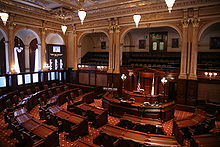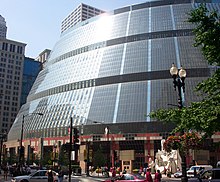Government of Illinois
Government of Illinois | |
|---|---|
bicameral body consisting of the 118-member House of Representatives and the 59-member Senate. The judiciary is composed of the Supreme Court of Illinois and lower courts.
ExecutiveThe executive branch is composed of six elected officers and their offices, as well as numerous other departments.[1] Illinois is one of 26 states that elect their governor on the same ticket as their lieutenant governor.[2] The six elected officers are: DepartmentsThe government of Illinois has numerous departments, agencies, boards and commissions; however, the code departments, so called because they are established by the Civil Administrative Code of Illinois, provide most of the state's services:[1][3]
Former Lt. Governor and Attorney General Neil Hartigan currently serves as General Counsel to The Governor of Illinois (J.B. Pritzker). Regulations are codified in the Illinois Administrative Code.[4] The Illinois Register is the weekly publication containing proposed and adopted rules.[4] Legislature The Speaker and Speaker pro tempore, and senators elect from the chamber a President of the Senate .
The Governor has different types of vetoes, such as a full veto, reduction veto, and an amendatory veto, but the General Assembly has the power to override gubernatorial vetoes through a three-fifths majority vote of each chamber. The General Assembly's session laws are published in the official Laws of Illinois.[5][6] The Illinois Compiled Statutes (ILCS) are the codified statutes of a general and permanent nature.[4][6] JudiciaryDaley Center in Chicago houses offices and courtrooms for the Cook County Circuit Court The appellate jurisdiction. It has mandatory jurisdiction in capital cases and cases where the constitutionality of laws has been called into question, and has discretionary jurisdiction from the Appellate Court. The Appellate Court is the court of first appeal for civil and criminal cases rising in the Illinois circuit courts.
The circuit courts are trial courts of original jurisdiction. There are 24 judicial circuits in the state, each comprising one or more of Illinois' 102 counties.[7] The circuit court has general jurisdiction and can decide, with few exceptions, any kind of case. Capital city Springfield is the state capital. Many state offices are in Springfield, and it is the regular meeting place of the Illinois General Assembly.[8] All officers chosen in statewide elections are required to have at least one residence in Springfield, funded by the state government.[9] Most cabinet officers and constitutional officers conduct a majority of their business in Chicago, with offices at the University of Illinois researcher and former member of the Illinois legislature Jim Nowlan stated "It’s almost like Chicago is becoming the shadow capital of Illinois" and that "Springfield is almost become a hinterland outpost."[9] A former director of the Southern Illinois University Paul Simon Institute for Public Affairs, Mike Lawrence, criticized state officials for spending so little time in Springfield since it estranged them from and devalued Illinois state employees in that city.[9]
In 2007, Illinois state representative Raymond Poe sponsored House Bill 1959, which proposed ending state financing for officers' travel to Springfield. "The state capital is Springfield, and that should be their work location," said Poe. [10] Local government The administrative divisions of Illinois are the counties, townships, precincts, cities, towns, villages, and special-purpose districts.[11] Illinois has more units of local government than any other state—over 8,000 in all. The basic subdivision of Illinois are the 102 counties.[12] 85 of the 102 counties are in turn divided into 1,432 townships.[12] Municipal governments are the cities, villages, and incorporated towns.[12] Some localities possess "home rule", which allows them to govern themselves to a certain extent.[13] Illinois counties, townships, cities, and villages may promulgate local ordinances.[14] Illinois also has several types of school districts (including the Chicago Public Schools and the Illinois Community College System) and additional units of government that oversee many other functions. See also
References
External links
|







